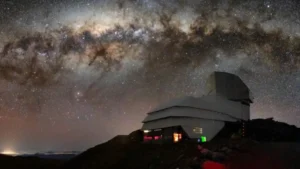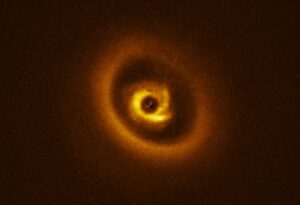The world’s most advanced astronomical camera is ready to begin its job atop a Chilean mountaintop, probing for astronomical events in glorious 3.2-gigapixel detail.
The Legacy Survey of Space and Time, or LSST, is undergoing final assembly in California and will soon travel to northern Chile. Here, in the dry, clear atmosphere, it will crown the Vera C. Rubin Observatory.
Although touted as a gigapixel camera, the LSST is more than that. In addition to the humongous 60cm-wide sensor, an optical telescope with a large aperture (able to gather imagery in low light) and a wide-angle view will give astronomers the unprecedented ability to crop slivers of the universe for detailed study. An advanced data management system will help with the analysis.
Let’s dig a little deeper into what the LSST might mean for space exploration.
The Rubin Observatory and LSST

The Vera C. Rubin Observatory in Cerro Pachon, Chile. Photo: Obs/NSF/AURA
The observatory lies on Cerro Pachon (2,715m), a mountain within the Atacama Desert, the driest place on earth. The lack of atmospheric moisture gives skies exceptional clarity there, and the remote location is also free from light pollution.
Scientists have already charted the initial regions of space where the camera will turn its eye. Over 10 years, it will capture some 500 quadrillion bytes (or ‘petabytes’) of data. This, they hope, will “address some of the most pressing questions about the structure and evolution of the universe and the objects in it.”
Its work includes:
- Probing for dark energy and dark matter
- Taking inventory of the solar system
- Mapping the Milky Way
The telescope
From the ridgeline of Cerro Pachon, the 8.4m Simonyi telescope’s triple mirror set, coupled with its fast, automated cadence, can capture clear images of the entire sky within three nights. Over the survey’s decade-long span, the LSST will collect 800 panoramic images.

The LSST telescope mount assembly and project team. Photo: Astturfeito/Obs/NSF/AURA
The LSST will house the largest digital camera ever made for astronomy. The device is about the size of a compact car and clocks in at three tons. The 3.2-billion pixels of solid-state detectors within its 60cm-wide sensor produce a resolution exact enough to capture a golf ball’s dimples from 25 km away.
According to researchers at the SLAC Lab, displaying one LSST image at full resolution and size takes the equivalent of 1,500 high-def TVs or 378 4K ultra-high-def TVs.
Making sense of it all
The collected data will feed into a data processing system. Here, specialized software will process up to 20 terabytes of info per night, producing usable images. It will also detect astronomical events. Within one minute of detecting an anomaly, the system can flag the occurrence and alert astronomers.

The Rubin Observatory in Cerro Pachon, Chile. Photo: Bruno C. Quint
Project coordinators estimate that the LSST will be up and running by 2023. Learn more and stay up to date on forthcoming developments at lsst.org and follow the Rubin Observatory on Instagram.





